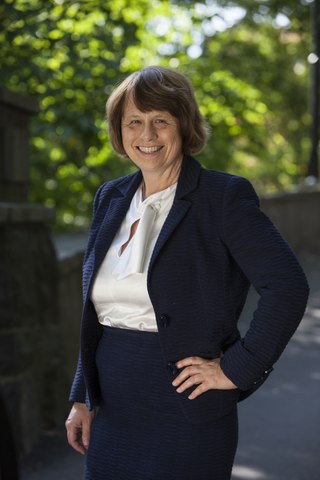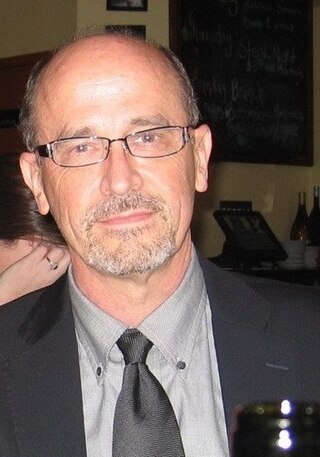
Sandra Moore Faber is an American astrophysicist known for her research on the evolution of galaxies. She is the University Professor of Astronomy and Astrophysics at the University of California, Santa Cruz, and works at the Lick Observatory. She has made discoveries linking the brightness of galaxies to the speed of stars within them and was the co-discoverer of the Faber–Jackson relation. Faber was also instrumental in designing the Keck telescopes in Hawaii.

Dame Susan Jocelyn Bell Burnell is an astrophysicist from Northern Ireland who, as a postgraduate student, discovered the first radio pulsars in 1967. The discovery eventually earned the Nobel Prize in Physics in 1974; however, she was not one of the prize's recipients.

Wilhelm Heinrich Walter Baade was a German astronomer who worked in the United States from 1931 to 1959.

Virginia Louise Trimble is an American astronomer specializing in the structure and evolution of stars and galaxies, and the history of astronomy. She has published more than 600 works in Astrophysics, and dozens of other works in the history of other sciences. She is famous for an annual review of astronomy and astrophysics research that was published in the Publications of the Astronomical Society of the Pacific, and often gives summary reviews at astrophysical conferences. In 2018, she was elected a Patron of the American Astronomical Society, for her many years of intellectual, organizational, and financial contributions to the society.

Ewine Fleur van Dishoeck is a Dutch astronomer and chemist. She is Professor of Molecular Astrophysics at Leiden Observatory, and served as the President of the International Astronomical Union (2018–2021) and a co-editor of the Annual Review of Astronomy and Astrophysics (2012–present). She is one of the pioneers of astrochemistry, and her research is aimed at determination of the structure of cosmic objects using their molecular spectra.
Jay Myron Pasachoff was an American astronomer. Pasachoff was Field Memorial Professor of Astronomy at Williams College and the author of textbooks and tradebooks in astronomy, physics, mathematics, and other sciences.

This article discusses women who have made an important contribution to the field of physics.
Lisa Jennifer Kewley is an Australian Astrophysicist and current Director of the Center for Astrophysics | Harvard & Smithsonian. Previously, Kewley was Director of the ARC Centre of Excellence for All Sky Astrophysics in 3-D and ARC Laureate Fellow at the Australian National University College of Physical and Mathematical Sciences, where she was also a Professor. Specialising in galaxy evolution, she won the Annie Jump Cannon Award in Astronomy in 2005 for her studies of oxygen in galaxies, and the Newton Lacy Pierce Prize in Astronomy in 2008. In 2014 she was elected a fellow of the Australian Academy of Science. In 2020 she received the James Craig Watson Medal. In 2021 she was elected as an international member of the National Academy of Sciences. In 2022 she became the first female director of the Center for Astrophysics | Harvard & Smithsonian.

Katherine Freese is a theoretical astrophysicist. She is currently a professor of physics at the University of Texas at Austin, where she holds the Jeff and Gail Kodosky Endowed Chair in Physics. She is known for her work in theoretical cosmology at the interface of particle physics and astrophysics.

Nicholas B. Suntzeff is an American astronomer and cosmologist. He is a University Distinguished Professor and holds the Mitchell/Heep/Munnerlyn Chair of Observational Astronomy in the Department of Physics & Astronomy at Texas A&M University where he is Director of the Astronomy Program. He is an observational astronomer specializing in cosmology, supernovae, stellar populations, and astronomical instrumentation. With Brian Schmidt he founded the High-z Supernova Search Team, which was honored with the Nobel Prize in Physics in 2011 to Schmidt and Adam Riess.
Lennox Lauchlan Cowie FRS is a British astronomer, and professor at the Institute for Astronomy, University of Hawaiʻi.

Jacqueline Nina Hewitt is an American astrophysicist. She was the first person to discover an Einstein ring. She is a Fellow of the American Astronomical Society.
Kristen Sellgren is an American retired astronomer and Professor Emerita at the College of Natural and Mathematical Sciences, Ohio State University. She won the Newton Lacy Pierce Prize in Astronomy in 1990. She is the founder of American Astronomical Society's Committee for Sexual-Orientation & Gender Minorities in Astronomy (SGMA).
Rachel Bean is a cosmologist and theoretical astrophysicist. She is a professor of astronomy and the interim dean of the Cornell University College of Arts and Sciences.

Megan Donahue is an American astronomer who studies galaxies and galaxy clusters. She is a professor of physics and astrophysics at Michigan State University, and the president of the American Astronomical Society for the 2018–2020 term.
Sera Markoff is an American astrophysicist and full professor of theoretical high energy astrophysics at the Anton Pannekoek Institute for Astronomy, University of Amsterdam. She is a member of the Event Horizon Telescope team that produced the first image of a black hole.
The Lise Meitner Lectures (LML) are a series of public lectures in honour of Lise Meitner. The lectures are organized jointly by the German Physical Society and the Austrian Physical Society, with the intention to showcase outstanding female scientists in physics or related fields. The annual lecture series was launched in 2008, when Lise Meitner's birthday celebrated its 130th anniversary. In October 2008, the Lise Meitner Lecture was held in Vienna and Berlin with an accompanying exhibition. The annual lecture series not only aims at increasing the visibility of successful female researchers, but also at encouraging girls and young women towards careers in physics.

Dara J. Norman is an astronomer and the deputy director of the Community Science and Data Center at the National Science Foundation's National Optical-Infrared Astronomy Research Laboratory (NOIRLab) in Tucson, Arizona. She is also the Association of Universities for Research in Astronomy Diversity Advocate at NOAO. Her research centers on the influence of Active Galactic Nuclei (AGN) on the evolution of galaxies. In 2020, she was inducted into the inaugural cohort of American Astronomical Society Fellows in recognition of her leadership and achievements.
Linda Siobhan Sparke is a British astronomer known for her research on the structure and dynamics of galaxies. She is a professor emerita of astronomy at the University of Wisconsin–Madison, and Explorers Program Scientist in the NASA Astrophysics Division.
Charlene Heisler was a Canadian astronomer. She is best known for her work on Active Galactic Nuclei (AGN). The Astronomical Society of Australia created the Charlene Heisler Prize in her honour.











